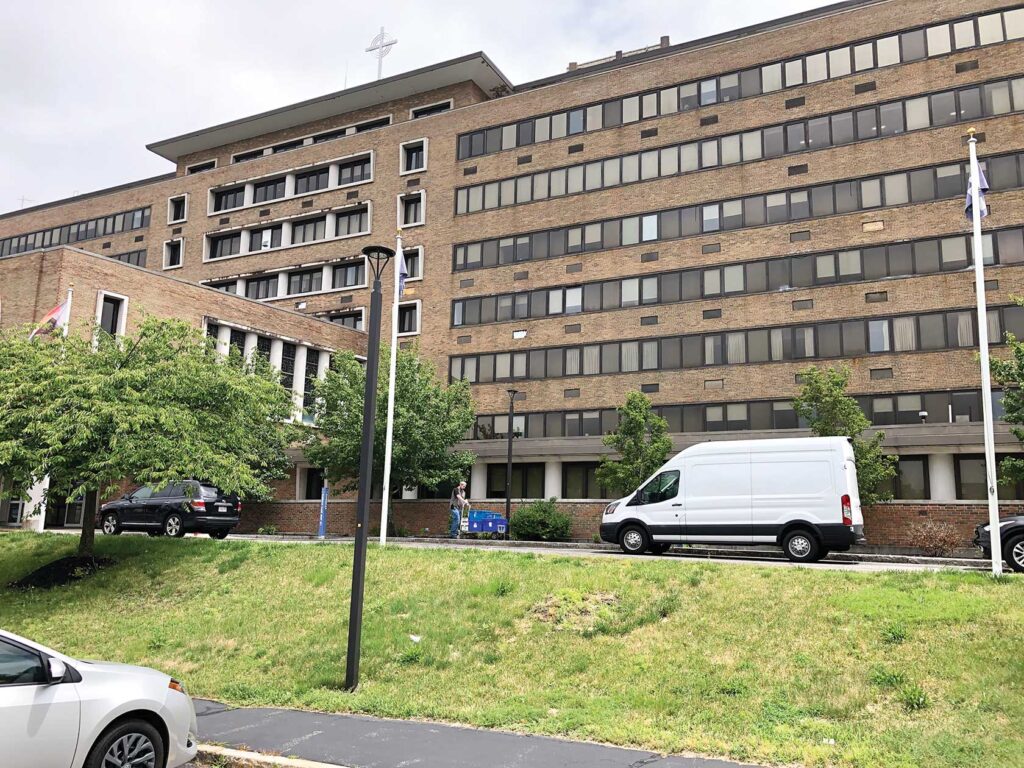Carney Hospital’s pending closure leaves health centers bracing for impact
State says no path forward, amid calls to declare a public health emergency

Last month’s announcement from Steward Health Care that it would close Carney Hospital in Dorchester sent shockwaves through the community.
The move earned rebuke and pushback from local community leaders and elected officials who said the closure could worsen existing health disparities.
But for the community health centers right in the hospital’s shadow — facilities like Harvard Street Neighborhood Health Center, DotHouse Health and Codman Square Community Health Center — Carney’s pending closure means bracing for the potential influx of new patients in a system that is often already at its limits.
“We’re tapped,” said Charles Murphy, president and CEO of Harvard Street Neighborhood Health Center. “We’re pretty much at capacity and doing the best we can.”
The health care system in the city and state is one that providers say is already overburdened, with challenges in recruiting and retaining doctors and other staff in an incredibly competitive market.
The closure of Carney Hospital would mean the loss of a giant in the area. The hospital has about 150 beds overall and 70 psychiatric beds in particular. In June, its emergency department saw over 2,600 visits.
“It’s hard to think that any one or several providers could take on that volume,” said Michelle Nadow, CEO at DotHouse Health.
Short notice
The rapid timeline of the pending closure — Steward proposed a timeline of just over a month to shutter Carney as well as Nashoba Hospital in Ayer — also raises flags for local advocates like Bill Walczak, a former president of Carney Hospital and the founder of nearby Codman Square Community Health Center.
“The notion that, somehow, we’re being put in the position of seeing a hospital close in a month seems like something that should not be allowed to happen,” Walczak said. “Beyond that, we shouldn’t be considering idea of closing a hospital that understands what the needs are of this section of the city.”
Carney Hospital also provides services that the health centers regularly draw on, leaders at those community health organizations said.
Murphy said Harvard Street Neighborhood Health Center regularly refers patients to Carney Hospital to get X-rays or visit specialties like urology that the center doesn’t have onsite.
“With Carney closing its doors, it’s a matter of finding other providers for the referrals,” Murphy said. “Providers are tapped out, whether it’s [Boston Medical Center], [Beth Israel Deaconess Milton], whatever the case may be, it’s just going to be more difficult to find the specialty care that our current clients need.”
Carney Hospital has also been recognized for being well-equipped to serve the diverse community of residents in surrounding Dorchester, Mattapan and other nearby neighborhoods.
At a rally and press conference July 29, Rep. Ayanna Pressley said she and her family have been patients at Carney Hospital and particularly highlighted its “patient-centered, culturally competent, compassionate” care.
Nadow said that, while DotHouse Health officially partners with Boston Medical Center for referrals, some patients opt instead to go to Carney Hospital.
“They know the language access is just there; it’s the proximity in their neighborhood; they don’t need to navigate a larger campus or go down downtown or other places; there’s parking there,” Nadow said. “I think for a lot of those reasons, there was a real strong affinity for some patients to go to go to Carney and have their needs met there. Without that, who will then take these referrals?”
A grim outlook
Despite community support and multiple rallies at the hospital, the potential to keep the hospital open looks grim.
On Aug. 1, Christopher Lopez, a federal judge in the U.S. Bankruptcy Court in Houston where the closures were announced about a week earlier, approved Steward Health Care’s plan to shutter the two hospitals.
The closures come as part of an ongoing saga of the foundering for-profit health care company.
Last winter, the hospital chain found itself in the crosshairs of the Healey-Driscoll administration, which was seeking long-overdue financial statements from the company in light of concerns about grave financial distress. When, by late February, Steward failed to comply with the request — which was further backed up by a court order — Healey called for the company to sell its hospitals and stop operations in the state. Months later, in May, the company filed for bankruptcy.
Now, while advocates take issue with the expedited timeline, which goes against state regulations, and the far-off courtroom in which the action is playing out, the state largely seems to be accepting the outcome.
“The problem is that the state seems to be just accepting what the judge in Texas is saying needs to happen,” Walczak said. “There’s no reason why the state should need to accept that.”
State regulations from the Department of Public Health outline a 120-day process, with multiple formal notifications to the state, as well as a public hearing held 60 days before a proposed closure. Steward Health Care’s intended plan would close Carney Hospital in just under 40 days from when it was first announced.
He said he thinks the Healey Administration should declare a public health emergency and take over the hospital to keep it open so it can continue to provide care — a call that was also made by state Sen. Nick Collins at the press conference July 29 — but according to reporting by WBUR, attorneys for the state said that while they are disappointed, they will work with Steward officials to relocate patients.
Collins also called for support of state legislation that would create the ability for the state to take a hospital under receivership, a process that would install a new leader for the facility. He suggested the state should provide adequate funding to keep the hospital operational until a qualified bidder is found.
On Aug. 1, Gov. Maura Healey said she is pressing back on Steward’s plan, calling on the company to adhere to the state regulations. But, according to reporting from Axios Boston, Healey also said that “there’s nothing that the state can do.”
In a statement to the Banner, a spokesperson for the Executive Office of Health and Human Services said the administration shares the community’s frustrations but the path forward is to ensure that any closure plan looks out for patient well-being.
“Steward made the decision to close these hospitals because they did not receive qualified bids. What they need to do now is present a responsible closure plan that outlines how they will protect patient safety,” the spokesperson said.
In the statement, the spokesperson called on Steward Health Care and its financial partners to “put their greed aside” and finalize deals for the other seven hospitals owned by the group.
Some state efforts are looking to address gaps that might appear with the loss of Carney Hospital. In May, the Healey-Driscoll administration activated an Incident Command System to assess clinical quality and access in Eastern Massachusetts due to the financial challenges faced by Steward Health Care.
Murphy, whose health center has been one of the stakeholders communicating with Steward and the Incident Command System, said the effort has been focused on identifying where access and capacity exists within the system.
The efforts of that group have “morphed,” following a plan established when the command structure was first launched, to include a team focused on responding to closures, said Bridget Stewart, one of five regional captains in the effort, but the group is focused on mitigating impact from a closure, not preventing or delaying it.
“We’re looking at how do we safely work with Steward and the community, to make sure that we’re looking at all essential services as part of the closure,” she said. “We’re anticipating that some of the other hospitals will be transitioning care, so, making sure that we have safe, high-quality, reliable care for those in the community.”






